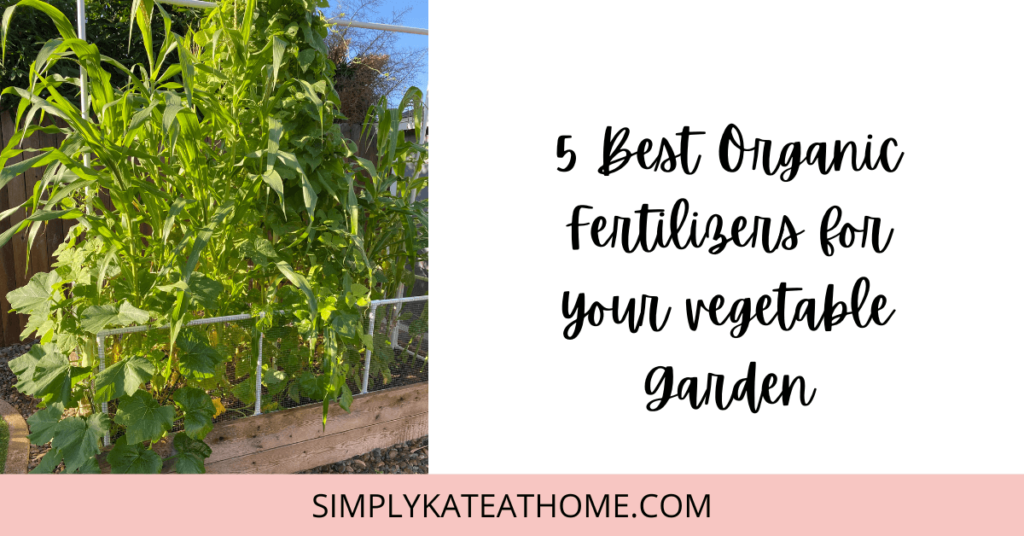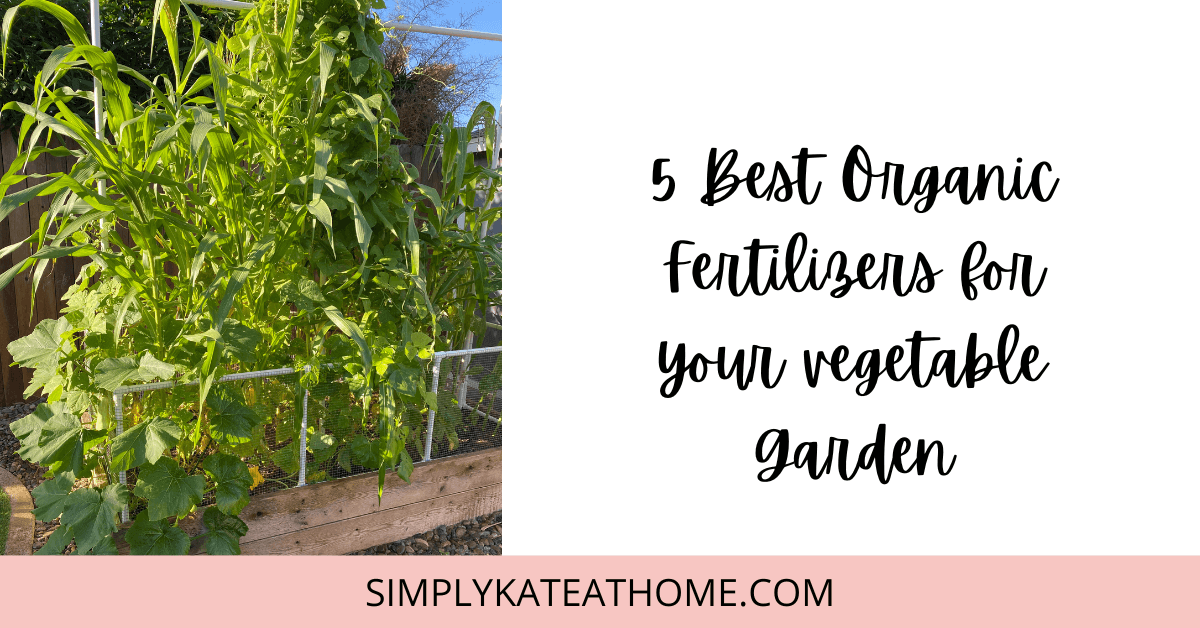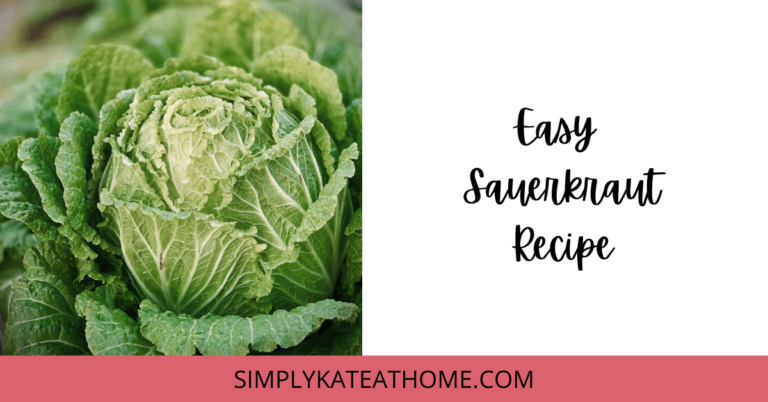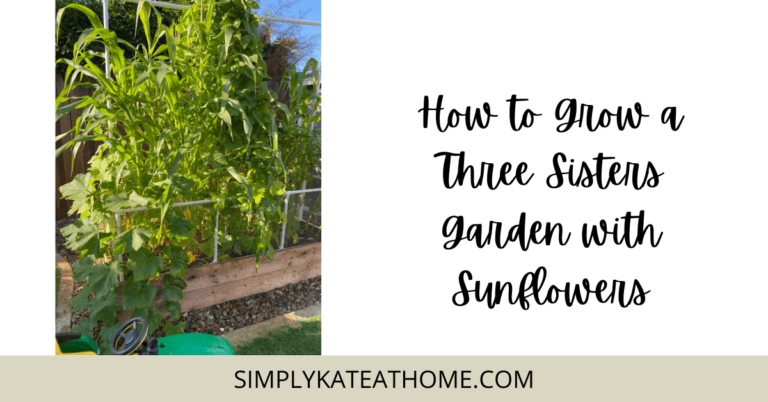5 Best Organic Fertilizers For Your Vegetable Garden
5 Best Organic Fertilizers For Your Vegetable Garden
I always find myself staring at the gorgeous organic gardens on Pinterest… you, too? They’re bushy and fruitful, and bursting with vibrant greens and reds. I want that! And I’m sure you do too. So how do they do it? We’re going to dig into the 5 best organic fertilizers for your vegetable garden.
There’s nothing more heartbreaking than planning and planting your vegetable garden, only to have the harvest be a complete flop. Trust me, I’ve been there. Yelling “BUT WHYYYYY” into the wind and concerning my neighbors with my state of disappointment… wasn’t a good look for me.
There are a variety of factors that come into play with organic gardening (can anyone say “bugs”?) but it often comes down to the soil quality. I was a rookie gardener and never realized that my tomatoes are nitrogen suckers, leaving my soil depleted, or that many vegetables rely on a variety of nutrients to grow and thrive.
After doing some serious research about the best organic fertilizers for my vegetable garden, I’ve decided on a list of five that I will always continue to use and have on hand.
Keep reading to learn the 5 best organic fertilizers for your vegetable garden and how to use them!
Note: Simply Kate At Home is reader-supported. When you buy through links on our site, we may earn an affiliate commission at no extra cost to you. It probably won’t be much, maybe pennies, but I’d really like a new vacuum. So, I’ll be patient.

5 Best Organic Fertilizers For Your Vegetable Garden
I would highly suggest starting this endeavor by getting a home soil test kit. This gives you a more accurate idea of what your soil is actually missing before you go buying different organic fertilizers and potentially wasting money. The kits are super easy to use and give rapid results.
Alright, after you’ve done your soil test and have a better idea of where you’re over or under on a particular nutrient, you can tailor your needs based on these recommended organic fertilizers. Here we go!
Admittedly, this stuff is stinky. If you order it, please wait until you get outside to open the box it comes in. You’ve been warned! It’s a great all-around fertilizer that has a variety of uses. It has an NPK ratio of 2-3-1.
You’ll use 1oz per 1 gallon of water, and apply it every 1-2 weeks. I usually use it every two weeks through the growing season. It’s a great organic option for all your growing needs! Think trees, lawn, vegetables, flowers, etc. It’s been known to revive patches of dead grass thanks to my dogs too…
This product has single-handedly saved my tomatoes from a sad fate. It’s a powder that you integrate into the soil prior to planting and then apply again in the middle of your plant’s life cycle. It has an NPK ratio of 4-6-3 and is super easy to use.
One thing I ran across recently was the new addition of the Prop65 warning on their packaging. Some people have gone up in arms about it being an issue, but you can read their response regarding the Prop65 warning here if you’re interested.
Liquid seaweed is one of the best organic fertilizers for your garden. It is an incredibly high-quality source of trace minerals and other macro/micro-nutrients that your plants can benefit from. It is good indoors and out, so be sure to give all your plants a little stinky goodness.
Several reviews online mentioned that you could take the dilution down to ½ oz (rather than 1oz) to one gallon of water, as 1oz may negatively affect your precious plants. Additionally, it is suggested on the bottle to use as a foliage spray, but I prefer to spray the roots instead as the liquid leaves behind a bit of a sticky residue.
Blood meal is a nitrogen amendment that can be just the fix your soil needs if that is all it is short on. It also can help raise the acid level of your soil for plants that prefer acidic soil (low pH). Tomatoes, squash, lettuce, and cucumbers are some of the more nitrogen-hungry plants you might be planting. It’s the best organic fertilizer for tomatoes!
You might be wondering “what is blood meal?” And just as an FYI, this is an animal product. Blood meal is usually cow blood that has been dried after the animals are killed. It can be made from other animals as well, and typically comes from meat packing plants. Please follow the instructions closely on this one, as too much nitrogen can burn your plants and possibly kill them.
Note: It also has the possibility of attracting unwanted visitors to your garden… aka dogs, possums, raccoons, and the like. I typically fence my gardens so furry visitors aren’t able to snack.
Fish fertilizer is another quick-acting liquid fertilizer made from fish byproducts. It’s really great on your lawn too, so don’t worry about accidental spillage there! ½ oz to a gallon of water, and drench the roots. No need to spray the foliage, as the nitrogen content could burn your plants.
DIY Fish Emulsion Fertilizer
The best part about fish emulsion fertilizer is that you can rest easy knowing it’s a sustainable product. It generally contains the fish scraps that would otherwise be tossed, including bones, fishtails, and fish guts. If you’re brave, you can easily make your own at home! A big bucket (a Home Depot 5 gallon WITH lid should do the trick!), fresh fish scraps, sawdust, and unsulfured molasses.
Mix one part fish scraps to three parts sawdust, and about ¼ to ½ cup of unsulfured molasses. Mix it up good and put the lid on tight. Drill some holes in the top to let the gasses out, but put a cloth or glue mesh down over top to keep the bugs out… otherwise, you’ll have a breeding ground for maggots…. You’ve been warned.
Give it a good stir every couple of days for at least two weeks, but it’s preferable to leave it for a month. After it’s done brewing, you can use 2-3 tablespoons per gallon of water as a soil drench once a month. It’ll be sure to supercharge your growing season! It’s good for about a year, and should be stored outside (or at least somewhere you won’t be subject to the stink).
- Bonus – Eggshells!
Eggshells have been a necessity in my garden for years. They’re so versatile and i’ll never go without them Typically I dry used shells and then crush them with my blender or mortar and pestle (yes, sometimes I bust it out). Once they’ve been ground down, I incorporate them into my soil in the fall to add calcium to the soil.
Throughout the year, I also use them as a slug deterrent by sprinkling them all over the top of the soil in my square-bed garden. Slugs and snails seem to hate crawling on top of them. Take that you little slimy guys!
When I initially plant veggies like tomatoes or cucumbers, I’ll also smash some up and put them in the hole before I add my seeds. Gives my plants a little boost as they start their growing season.
When To Fertilize Your Vegetable Garden
While I wish I had an easy answer for you about this, it sort of depends. Fertilizing your garden depends on some of the signs you’re seeing and where you are in your growing season. If you’re at the very beginning (aka you haven’t planted anything yet) it’s a good idea to get your necessary fertilizers into the soil before you actually plant. Every fall before the winter hits, it’s a good idea to amend your soil as well.
If you happen to have well-amended organic soil, you may not need to fertilize right off the bat, and may get away with only fertilizing once or twice through the growing season (lucky you!).
How To Fertilize Your Vegetable Garden
Take stock of what you are planting this season. Some veggies are nitrogen suckers (looking at you, tomatoes) and they might require a high nitrogen organic fertilizer. In any case, you’ll want to make sure that what you’re fertilizing with matches the needs of your vegetables.
I typically use dedicated spray bottles for each liquid fertilizer and label them accordingly with the date it was mixed and the type of fertilizer it is.
I also really enjoy a good tracking system. I’d hate to miss feeding my garden! (Or over-fertilizing and killing my plants… #beenthere). Right now, I just make reminders in my phone calendar when each fertilizer needs to be used. Eventually, I’ll use a dedicated garden planner… Stay tuned! I’m creating one as we speak.
Wrapping It Up
I hope this has been helpful in choosing the types of fertilizer you might use in your gardens this season.
Let me know in the comments below what you’ve added to your routine this year! Happy gardening!




